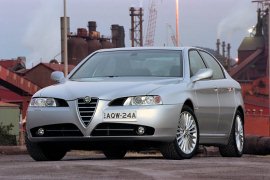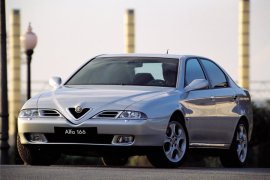ALFA ROMEO 166 Models/Series Timeline, Specifications & Photos
First production year: 1996
Engines: Gasoline, Diesel
Alfa Romeo introduced its flagship model, the 166, in 1998, and five years later, the Italian automaker enhanced it with the facelifted model, solving most of the car's issues.
Strangely, Italians were good at designing vehicles, but the 1998 Alfa Romeo 166 was not exactly a sought-after car. One of its main issues was with the front fascia, which featured ridiculously small headlights compared to the vehicle's size. In addition, its engines were not exactly what the brand's fans expected. But with the facelifted version, the fans got what they wanted.
The most significant aesthetic change was at the front fascia, where the Italian automaker installed taller headlights. In addition, it redesigned the hood and moved the specific "Alfa shield" into the lower area of the front fascia, and it was bigger. In addition, the lower bumper featured the "tri-lobo" design element that combined the main triangular-shaped grille with the lower horizontal lobes of the automaker's design language. At the back, the rear fascia remained virtually unchanged, at least in terms of shape.
Inside, the main upgrade was for the center stack. This received aluminum trims and a new infotainment center for vehicles fitted with that. But Alfa knew that its fans wanted high-bolstered seats and felt obliged to provide them. Even the rear bench was profiled for two passengers with almost no place for a third, middle occupant.
Under the hood, the Italian automaker narrowed the range of gasoline engines and expanded the turbo-diesel versions. It also cut a few versions and added others. In addition, the most potent Alfa Romeo 166 provided 240 PS (237 hp), 20 more than the non-facelifted version.
After almost a decade on the market, Alfa Romeo finally retired the 164 range in late 1996 and introduced the unusual-looking 166 in its lineup.
The Italian premium automaker had a long history of producing luxury vehicles. Still, after 1990, they struggled to keep up with the Germans, the British, and French carmakers. But Alfa Romeo had the edge over its competitors in terms of design. That happened with the 166 lineups too.
Walter da Silva worked for Centro Stile Alfa Romeo when he penned the luxury sedan. He imagined the car with some of the smallest headlights from those times in the automotive industry. Thus the front fascia was very slim for a mid-size sedan. To solve the engine's cooling needs, he added a broad grille on the apron that complemented the small, palm-sized grille placed above the bumper. From the profile, the ascending beltline of the car made it look dynamic even when it stood still. At the back, the high-mounted red taillights were wide but thick enough to match the headlamps.
Inside, the automaker installed bolstered bucket seats at the front, which provided adequate side support during high-speed cornering maneuvers. However, the dashboard looked like it surrounded the driver and their side passenger into separate cocoons. Furthermore, the center stack was tilted toward the driver's area, while the tall center console separated the two front seats. At the back, the bench was profiled for two, with a third slimmer and shorter center section.
Under the hood, the 166 received a wide engine choice from Alfa Romeo. It started from a 150-hp twin-spark engine up to a 3.0-liter, naturally-aspirated V6. In addition, due to the Italian taxation system, it offered a 200 hp, turbocharged, 2.0-liter V6. Finally, for those looking for better fuel efficiency, Alfa Romeo installed a 2.4-liter turbo-diesel.

